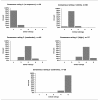Panel classification of self-reported exposure histories: a useful exposure index after a mass-casualty event
- PMID: 18051670
- PMCID: PMC1997245
- DOI: 10.1177/003335490712200609
Panel classification of self-reported exposure histories: a useful exposure index after a mass-casualty event
Abstract
Objective: Although rapid epidemiologic investigations of toxic exposures require estimates of individual exposure levels, objective measures of exposure are often unavailable. We investigated whether self-reported exposure histories, when reviewed and classified by a panel of raters, provided a useful exposure metric.
Methods: A panel reviewed exposure histories as reported by people who experienced a chlorine release. The panelists received no information about health-care requirements or specific health effects. To each exposure case, each panelist assigned one of five possible exposure severity ratings. When assigned ratings were not in initial agreement, the panelists discussed the case and assigned a consensus rating. Percent agreement and kappa statistics assessed agreement among panelists, Kendall's W measured agreement among panelists in their overall ordering of the exposure histories, and Spearman's rho compared the resultant rankings with individual health outcome.
Results: In 48% of the cases, the panelists' initial ratings agreed completely. Overall, initial ratings for a given case matched the consensus rating 69% to 89% of the time. Pair-wise comparisons revealed 85% to 95% agreement among panelists, with weighted kappa statistics between 0.69 and 0.83. In their overall ranking of the exposure histories, the panelists reached significant agreement (W = 0.90, p < 0.0001). Disagreement arose most frequently regarding probable chlorine concentration and duration of exposure. This disagreement was most common when panelists differentiated between adjacent categories of intermediate exposure. Panel-assigned exposure ratings significantly correlated with health outcome (Spearman's rho = 0.56; p < 0.0001).
Conclusion: Epidemiologists and public health practitioners can elicit and review self-reported exposure histories and assign exposure severity ratings that predict medical outcome. When objective markers of exposure are unavailable, panel-assigned exposure ratings may be useful for rapid epidemiologic investigations.
Figures
References
-
- Belson MG, Schier JG, Patel MM. Case definitions for chemical poisoning. MMWR Recomm Rep. 2005;54(RR-1):1–24. - PubMed
-
- Sexton K, Adgate JL, Mongin SJ, Pratt GC, Ramachandran G, Stock TH, et al. Evaluating differences between measured personal exposures to volatile organic compounds and concentrations in outdoor and indoor air. Environ Sci Technol. 2004;38:2593–602. - PubMed
-
- Sexton K, Adgate JL, Ramachandran G, Pratt GC, Mongin SJ, Stock TH, et al. Comparison of personal, indoor, and outdoor exposures to hazardous air pollutants in three urban communities. Environ Sci Technol. 2004;38:423–30. - PubMed
MeSH terms
Substances
LinkOut - more resources
Full Text Sources



